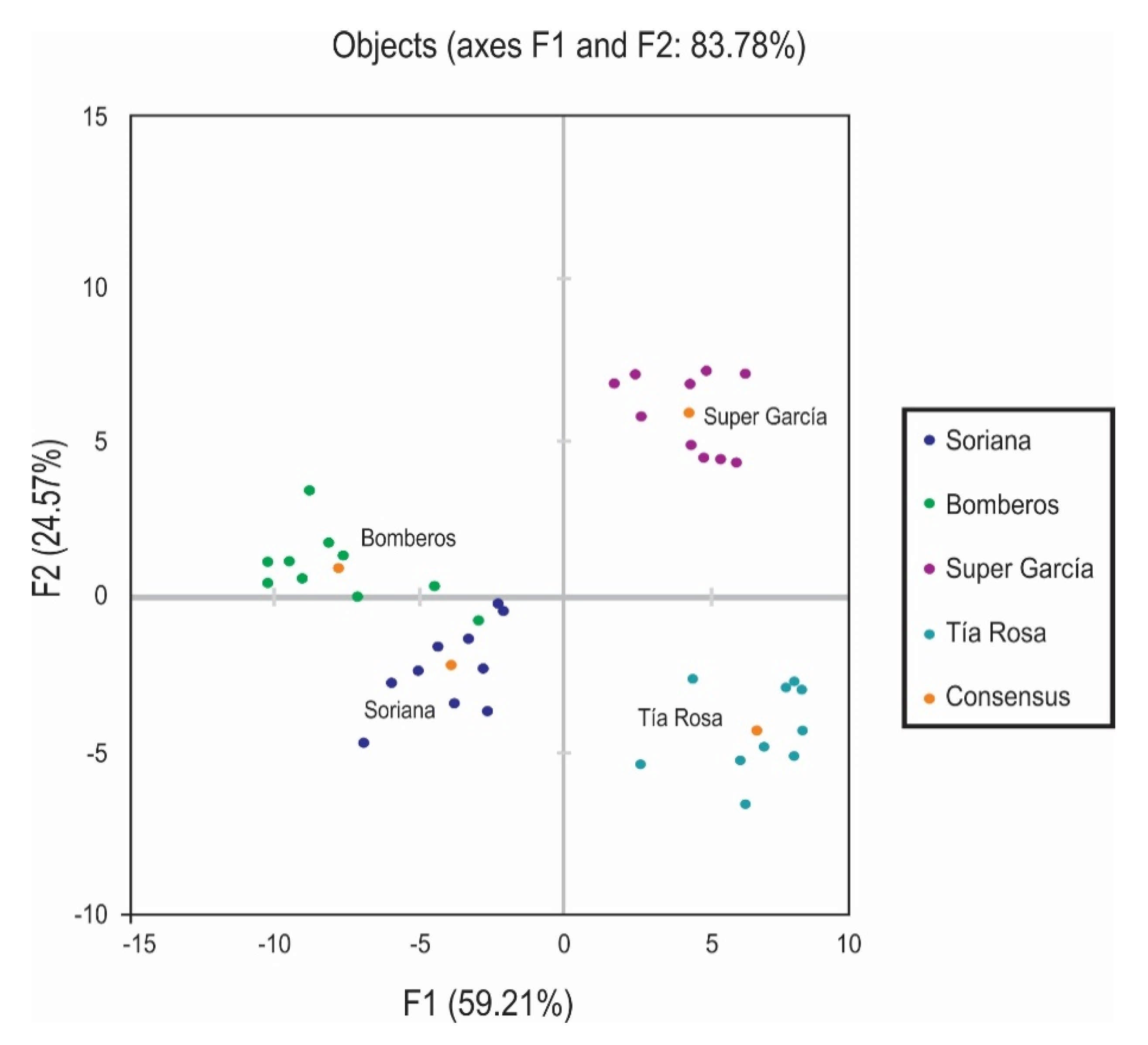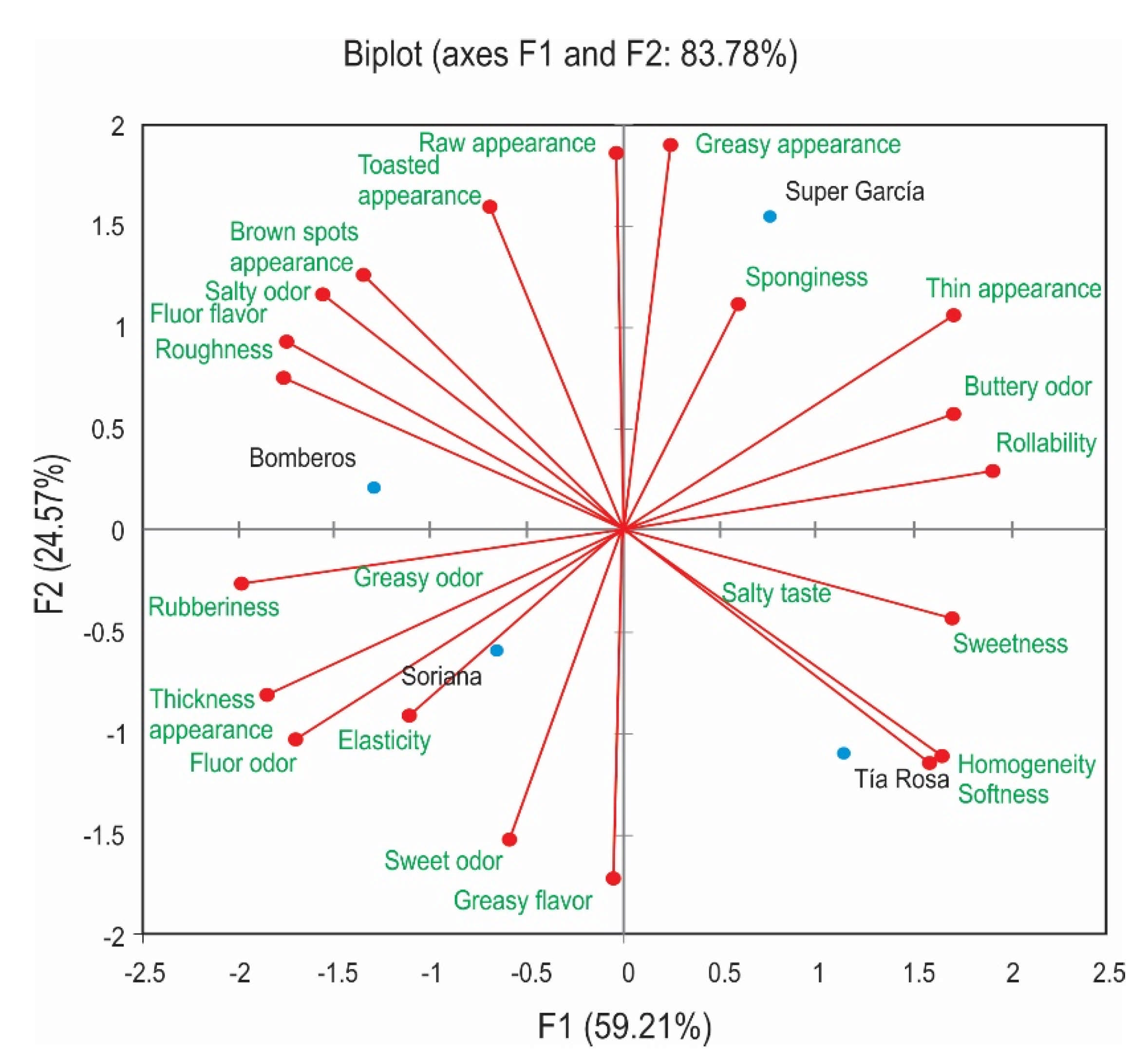Developing a Descriptive Sensory Characterization of Flour Tortilla Applying Flash Profile
Abstract
1. Introduction
2. Materials and Methods
2.1. Materials
2.2. Consumption and Preferences of Flour Tortilla Consumers
2.3. Flash Profile
2.3.1. Samples
2.3.2. Panel
2.3.3. Sensory Evaluation Procedure
2.3.4. Data Analysis Method
3. Results and Discussion
3.1. Consumption and Preferences of Flour Tortillas by Consumers
3.2. Flash Profile Methodology
4. Conclusions
Author Contributions
Funding
Acknowledgments
Conflicts of Interest
References
- Anton, A.A.; Ross, K.A.; Lukow, O.M.; Fulcher, R.G.; Arntfield, S.D. Influence of added flour (Phaseolus vulgaris L.) on some physical and nutritional properties of wheat flour tortillas. Food Chem. 2008, 109, 33–41. [Google Scholar] [CrossRef] [PubMed]
- Liu, J.; Schou Grønbeck, M.; Di Marco, R.; Giacalone, D.; Bredie, W.L.P. Performance of Flash profile and napping with and without training for describing small sensory differences in a model wine. Food Qual. Prefer. 2015, 48, 1–31. [Google Scholar] [CrossRef]
- Liu, T.; Hou, G.G.; Book, S.L.; Marquart, L. Effects of chemical leavening system and processing conditions on the opacity and other quality characteristics of whole-wheat flour tortillas. LWT 2016, 73, 123–130. [Google Scholar] [CrossRef]
- Terhaag, M.M.; Benassi, M.T. Flash profile: An alternative for quick descriptive analysis. Braz. J. Food Technol. 2011, 6, 140–151. [Google Scholar] [CrossRef]
- Anton, A.A.; Lukow, O.M.; Fulcher, R.G.; Arntfield, S.D. Shelf stability and sensory properties of flour tortillas fortified with pinto bean (Phaseolus vulgaris L.) flour: Effects of hydrocolloid addition. LWT 2009, 42, 23–29. [Google Scholar] [CrossRef]
- Tuncil, Y.E.; Jondiko, T.; Castell-Perez, M.E.; Puerta-Gomez, A.F.; Awika, J.M. Small deformation rheological properties of dough are useful tool to predict the effects of modest sodium reduction on flour tortilla quality. LWT 2016, 68, 329–333. [Google Scholar] [CrossRef]
- Páramo-Calderón, D.E.; Aparicio-Saguilán, A.; Aguirre-Cruz, A.; Carrillo-Ahumada, J.; Hernández-Uribe, J.P.; Acevedo-Tello, S.; Torruco-Uco, J.G. Tortilla added with Moringa oleífera flour: Physicochemical, textural properties and antioxidant capacity. LWT 2018, 100, 409–415. [Google Scholar] [CrossRef]
- Serna-Saldivar, S.O. History of Corn and Wheat Tortillas. In Tortillas: Wheat Flour and Corn Products, 1st ed.; Rooney, L.W., Serna-Saldivar, S.O., Eds.; Woodhead Publishing and AACC International Press: Sawston, UK, 2015; Volume 1, pp. 1–28. ISBN 9781891127885. [Google Scholar]
- Bejosano, F.; Novie Alviola, J. Wheat Flour for Tortillas. In Tortillas: Wheat flour and Corn Products, 1st ed.; Rooney, L.W., Serna-Saldivar, S.O., Eds.; Woodhead Publishing and AACC International Press: Sawston, UK, 2015; Volume 1, pp. 146–158. ISBN 9781891127885. [Google Scholar]
- Ramírez Rivera, E.J.; Paz Gamboa, E.; Nogueira Terrones, H. Sensory characterization and preference analysis of consumers of fried taro (Colocasia esculenta) type chips. RVCTA 2011, 2, 277–292. [Google Scholar]
- Yeverino-Gutiérrez, M.L.; Gracia-Vásquez, Y.A.; Arteaga-Mac, K.G. Análisis fisicoquímico de las tortillas de harina de trigo que se expanden en el área metropolitana de Monterrey, N.L., Mexico. RESPYN 2010, 10, 1–5. [Google Scholar]
- Flores Vera, N.A. Entrenamiento de un Panel de Evaluación Sensorial para el Departamento de Nutrición de la Facultad de Medicina de la Universidad de Chile. Santiago, Chile. pp. 5–7. Available online: http://repositorio.uchile.cl/bitstream/handle/2250/137798/Entrenamiento-de-unpanel-de-evaluacion-sensorial-para-el-Departamento-de-Nutricion-de-la-Facultadde-Medicina-de-la-Universidad-de-Chile.pdf?sequence=1 (accessed on 12 December 2020).
- Puma-Isuiza, G.G.; Núñez, C. Determinación del perfil de textura sensorial de dos muestras experimentales de hot-dog de pollo (Gallus gallus) obtenidas por Ingeniería Kansei Tipo II. An. Científicos 2018, 79, 201–217. [Google Scholar] [CrossRef]
- Cosson, A.; Souchon, I.; Richard, J.; Descamps, N.; Saint-Eve, A. Using multiple sensory profiling methods to gain insight into temporal perceptions of pea protein-based formulated food. Foods 2020, 9, 969. [Google Scholar] [CrossRef]
- Lawless, H.T.; Heymann, H. Sensory Evaluation of Food: Principles and Practice, 2nd ed.; Springer Science & Business Media: New York, NY, USA, 2010; p. 596. ISBN 978-1-4419-6488-5. [Google Scholar]
- Dijksterhuis, G.B.; Gower, J.C. The interpretation of Generalized Procrustes analysis and allied methods. Food Qual. Prefer. 1991, 3, 67–87. [Google Scholar] [CrossRef]
- Delarue, J. Flash profile, its Evolution and Uses in Sensory and Consumer Science. In Rapid Sensory Profiling Techniques: Applications in New Product Development and Consumer Research, 1st ed.; Delarue, J., Lawlor, J.B., Rogeaux, M., Eds.; Woodhead Publishing Series in Food Science, Technology and Nutrition: Cambridge, UK, 2015; Volume 1, pp. 121–151. [Google Scholar] [CrossRef]
- Meullenet, J.F.; Xiong, R.; Findlay, C. Panelist and Panel Performance: A Multivariate Experience. In Multivariate and Probabilistic Analyses of Sensory Science Problems; Blackwell Publishing Professional: Oxford, UK, 2007; pp. 27–47. ISBN 9780813801780. [Google Scholar]
- Bredie, W.L.P.; Liu, J.; Dehlholm, C.; Heymann, H. Flash Profile Method. In Descriptive Analysis in Sensory Evaluation, 1st ed.; Kemp, S.E., Hort, J., Hollowood, T., Eds.; John Wiley & Sons Ltd.: Medford, MA, USA, 2018; pp. 513–533. ISBN 978-0-470-67139-9. [Google Scholar]
- Liu, J.; Bredie, W.L.P.; Sherman, E.; Harbertson, J.; Heymann, H. Comparison of rapid descriptive sensory methodologies: Free-choice profiling, Flash profile and modified Flash profile. Food Res. Int. 2018, 106, 892–900. [Google Scholar] [CrossRef]
- Punter, P.H. Free Choice Profiling. In Descriptive Analysis in Sensory Evaluation, 1st ed.; Kemp, S.E., Hort, J., Hollowood, T., Eds.; John Wiley & Sons Ltd.: Medford, MA, USA, 2018; pp. 493–511. ISBN 978-0-470-67139-9. [Google Scholar]
- Varela, P.; Ares, G. Sensory profiling, the blurred line between sensory and consumer science: A review of novel methods for product characterization. Food Res. Int. 2012, 48, 893–908. [Google Scholar] [CrossRef]
- Lorido, L.; Estévez, M.; Ventanas, S. Fast and Dynamic descriptive techniques (Flash profile, time-intensity and temporal dominance of sensations) for sensory characterization of dry-cured loins. Meat Sci. 2018, 145, 154–162. [Google Scholar] [CrossRef]
- Dairou, V.; Sieffermann, J.M. A comparison of 14 jams characterized by conventional profile and a quick original method, the Flash profile. J. Food Sci. 2002, 67, 826–834. [Google Scholar] [CrossRef]
- Delarue, J.; Sieffermann, J. Sensory mapping using Flash profile, comparison with conventional descriptive method for the evaluation of the flavour of fruit dairy products. Food Qual. Prefer. 2004, 15, 383–392. [Google Scholar] [CrossRef]
- Gkatzionis, K.; Hewson, L.; Hollowood, T.; Hort, J.; Dodd, C.E.R.; Linforth, R.S.T. Effect of Yarrowia lipolytica on blue cheese odour development: Flash profile sensory evaluation of microbiological models and cheeses. Int. Dairy J. 2013, 30, 8–13. [Google Scholar] [CrossRef]
- Moussaoui, K.A.; Varela, P. Exploring consumer product profiling techniques and their linkage to a quantitative descriptive analysis. Food Qual. Prefer. 2010, 21, 1088–1099. [Google Scholar] [CrossRef]
- Montanuci, F.D.; Rodrigues Marques, D.; Giriboni Monteiro, A.R. Flash profile for rapid descriptive análisis in sensory characterization of passion fruit juice. Acta Sci. Technol. 2015, 37, 337–344. [Google Scholar] [CrossRef][Green Version]
- Ser, G. Using Generalized Procrustes Analysis for evaluation of sensory characteristic data of lamb meat. TURJAF 2019, 7, 840–844. [Google Scholar] [CrossRef]
- Varela, P.; Ares, G. Novel Techniques in Sensory Characterization and Consumer Profiling; CRC Press: Boca Raton, FL, USA, 2014; p. 416. ISBN 9781138034273. [Google Scholar]
- Hernández-Cervantes, M.; López-Velázquez, J.; Gómez-Alvarado, T.; Santiago-Cabrera, R.; Ramón-Canul, L.G.; Delgado-Vidal, F.K.; Ramírez-Rivera, E.D. Comparación de la descripción sensorial del queso fresco “cuajada” mediante el análisis descriptivo cuantitativo y el perfil flash. Cienc. Mar. 2010, 42, 3–12. [Google Scholar]
- Silva-Paz, R.J.; Huamán-Llaja, M.A.; Hurtado de Mendoza-Merino, K.; Bravo-Araníbar, N.; Silva-Baigorria, A.S. Sensory characterization of mushroom sauce (Pleurotus ostreatus) using Flash profile technique. RVCYTA 2016, 7, 1–16. Available online: https://www.cabdirect.org/cabdirect/abstract/20173237722 (accessed on 11 May 2020).
- Ramírez, E.; Paz, E.; Nogueira, H. Caracterización sensorial y análisis de las preferencias de los consumidores de frituras tipo chips de Malanga (Colocasia esculenta). RVCYTA 2011, 2, 277–292. Available online: https://core.ac.uk/download/pdf/27176246.pdf (accessed on 23 May 2020).
- Wu, W.; Guo, Q.; De Jong, S.; Massart, D.L. Randomisation test for the number O dimensions of the group average space in generalised Procrustes analysis. Food Qual. Prefer. 2002, 13, 191–200. [Google Scholar] [CrossRef]
- Kobayashi, M.; Benassi, M. Caracterização sensorial de cafés solúveis comerciais por perfil flash. Ciências Agrárias. 2012, 33, 3081–3092. [Google Scholar] [CrossRef]
- Rason, J.; Léger, L.; Dufour, E.; Lebecque, A. Relations between the know-how of small-scale facilities and the sensory diversity of traditional dry sausages from the Massif Central in France. Eur. Food Res. Technol. 2006, 222, 580–589. [Google Scholar] [CrossRef]
- Ramírez, E.; Ramón, L.; Camacho, M.; Reyes, V.; Rodríguez, M.; Shaín, A. Correlación d entre el perfil descriptivo cuantitativo y perfil flash de hamburguesas de pescado de barrilete negro (Euthynnus lineatus). Ncameh 2010, 4, 55–68. [Google Scholar]
- Ramírez, E.; Ramón, L.; Huante, Y.; Shaín, A.; Bravo, H.; Martínez, C. Caracterización sensorial del camaron ahumado (Litopenaeus vannamei) mediante la técnica perfil flash. Cienc. Mar. 2009, 38, 27–34. [Google Scholar]
- Gamboa, J.; Guadalupe, D.; Ramírez, E. Calidad fisicoquímica y sensorial de queso tipo manchego durante la maduración. Sci. J. UDO Agrícola 2012, 12, 929–938. [Google Scholar]


| Flour Tortilla Brand | Ingredients |
|---|---|
| Bomberos | Wheat flour, iodized salt, baking powder and shortening. |
| Super García | Wheat flour, iodized salt, baking powder and shortening. |
| Soriana | Wheat flour, iodized salt, baking powder, shortening and milk. |
| Tía Rosa | Wheat flour, partially hydrogenated vegetable fat, iodized salt, sodium aluminum sulfate, monocalcium phosphate, mono and diglycerides, vegetable oil, enzymes, sugar, calcium propionate, sorbic acid, active soy enzymes, calcium peroxide. |
| Wheat Flour Tortilla Manufacture | Residual (%) |
|---|---|
| Soriana | 54.096 |
| Bomberos | 71.605 |
| Super García | 54.325 |
| Tía Rosa | 63.609 |
| Panelists | Residuals, % | Scaling Factors | F1, % | F2, % |
|---|---|---|---|---|
| 1 | 20.564 | 1.990 | 58.845 | 30.900 |
| 2 | 7.663 | 0.752 | 53.765 | 30.191 |
| 3 | 12.170 | 0.724 | 73.544 | 16.103 |
| 4 | 48.223 | 1.018 | 55.879 | 34.258 |
| 5 | 4.965 | 0.944 | 52.535 | 29.109 |
| 6 | 26.844 | 0.696 | 39.992 | 35.804 |
| 7 | 18.550 | 1.993 | 81.614 | 11.079 |
| 8 | 14.024 | 1.452 | 78.233 | 12.713 |
| 9 | 76.507 | 1.123 | 12.062 | 38.078 |
| 10 | 14.125 | 1.750 | 66.680 | 13.429 |
Publisher’s Note: MDPI stays neutral with regard to jurisdictional claims in published maps and institutional affiliations. |
© 2021 by the authors. Licensee MDPI, Basel, Switzerland. This article is an open access article distributed under the terms and conditions of the Creative Commons Attribution (CC BY) license (https://creativecommons.org/licenses/by/4.0/).
Share and Cite
Rodríguez-Noriega, S.; Buenrostro-Figueroa, J.J.; Rebolloso-Padilla, O.N.; Corona-Flores, J.; Camposeco-Montejo, N.; Flores-Naveda, A.; Ruelas-Chacón, X. Developing a Descriptive Sensory Characterization of Flour Tortilla Applying Flash Profile. Foods 2021, 10, 1473. https://doi.org/10.3390/foods10071473
Rodríguez-Noriega S, Buenrostro-Figueroa JJ, Rebolloso-Padilla ON, Corona-Flores J, Camposeco-Montejo N, Flores-Naveda A, Ruelas-Chacón X. Developing a Descriptive Sensory Characterization of Flour Tortilla Applying Flash Profile. Foods. 2021; 10(7):1473. https://doi.org/10.3390/foods10071473
Chicago/Turabian StyleRodríguez-Noriega, Sanjuana, José J. Buenrostro-Figueroa, Oscar Noé Rebolloso-Padilla, José Corona-Flores, Neymar Camposeco-Montejo, Antonio Flores-Naveda, and Xochitl Ruelas-Chacón. 2021. "Developing a Descriptive Sensory Characterization of Flour Tortilla Applying Flash Profile" Foods 10, no. 7: 1473. https://doi.org/10.3390/foods10071473
APA StyleRodríguez-Noriega, S., Buenrostro-Figueroa, J. J., Rebolloso-Padilla, O. N., Corona-Flores, J., Camposeco-Montejo, N., Flores-Naveda, A., & Ruelas-Chacón, X. (2021). Developing a Descriptive Sensory Characterization of Flour Tortilla Applying Flash Profile. Foods, 10(7), 1473. https://doi.org/10.3390/foods10071473









